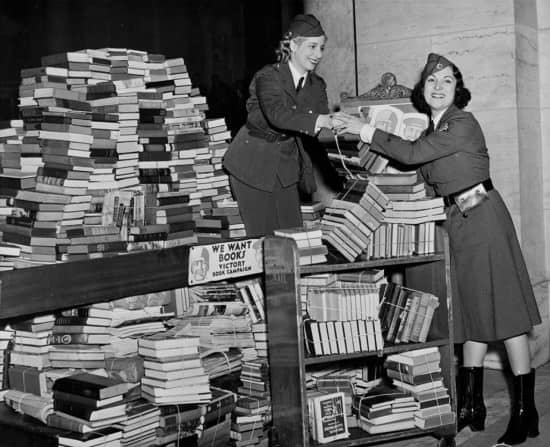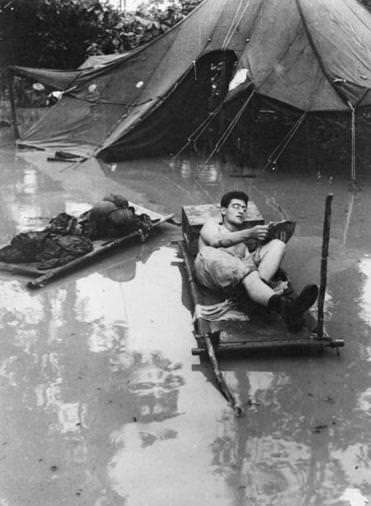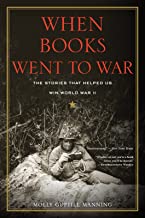When Books Went to War by Molly Guptill Manning
When Nazi Germany began invading neighboring countries in the 1930s it not only declared war on freedom, liberty, and tolerance—it declared war on the printed page as well. By 1941, the Nazis had banned and burned more than 100 million books and had driven terrified citizens to hide or destroy many more. But as the United States entered the war, books fought back.
Molly Guptill Manning’s When Books Went to War (Houghton Mifflin Harcourt, 2014) tells the remarkable tale of the power of literacy in the face of totalitarianism. It describes how an army of American librarians, along with the U.S. publishing industry, struck back against fascism and helped our men and women in uniform win the war.
“American librarians recognized the dangers of Nazi policies, and launched a counteroffensive,” Manning said. “They organized the largest book drives in history to collect books for Army training camps. Books became symbols of democracy and freedom.
[giveaway giveaway_id=1906 side=”right”]“As Americans were shipped to fronts around the world, publishers came together to print special pocket-sized paperbacks called Armed Services Editions (or ASEs), which were churned out in staggering numbers,” she said. “In the end, over 140 million books were given to American troops—more than Germany destroyed.”

American librarians fought against Germany’s destruction of books.
When Books Went to War tells the story of the Victory Book Campaign, the first effort of American librarians to use the power of literacy to strike back against the forces of evil. In the campaign, everyone from the Girl Scouts to President and Mrs. Franklin D. Roosevelt contributed hardcover books to the program. Roosevelt declared April 17, 1942 “Victory Book Day,” and in all, Americans donated more than 18 million copies to the cause.
In time, however, the troops discovered that bulky, heavy hardcovers were difficult to carry into battle. “This is when American publishers became involved and reinvented the book,” Manning said. “When the war began, the paperback industry was in its infancy. Tradition and profit caused most publishers and bookstores to favor hardcovers. When paper rationing was put into effect, the tide began to turn, because paperbacks used less paper.
 “But it was when publishers learned how badly servicemen needed portable books that they embraced the paperback format,” she said. “Publishers designed the ASEs to fit the hip or breast pocket of standard issue military uniforms. In total, there were 1,200 different books, ranging from Shakespeare to Sad Sack comics. As one soldier said, they were ‘as popular as pin-up girls.’ The books were precious reminders of home and a trusted source of distraction from the war whenever men needed a respite.”
“But it was when publishers learned how badly servicemen needed portable books that they embraced the paperback format,” she said. “Publishers designed the ASEs to fit the hip or breast pocket of standard issue military uniforms. In total, there were 1,200 different books, ranging from Shakespeare to Sad Sack comics. As one soldier said, they were ‘as popular as pin-up girls.’ The books were precious reminders of home and a trusted source of distraction from the war whenever men needed a respite.”
As ASEs spread throughout the European and Pacific theaters, they became one of the soldier’s most precious possessions. When soldiers shed their unnecessary weight before the Normandy invasion, they kept their ammunition and their books. When they were wounded and sitting on the beach, waiting for attention, they pulled out a book. Soldiers in the Pacific, stuck in foxholes on various islands, reached for their books. Even in the middle of action, soldiers kept reading. “The books are read until they’re so dirty you can’t see the print,” wrote one corporal at sea to the Council on Books in Wartime. “To heave one in the garbage is tantamount to striking your grandmother.”

An American serviceman takes respite with an Armed Services Editions book in what remained of his. Australian War Memorial
The American serviceman’s voracious appetite for reading, in turn, had a remarkable effect on the publishing industry. It established the paperback as a viable product, making books available to the middle class for as low as a quarter a copy. With paperbacks affordable for all, book buying was no longer a sign of wealth, and reading became a universal pastime. Also, having read books under the most trying of times, servicemen felt that they could thrive in college, and millions of them went on to seek higher education under the G.I. Bill.
Specific titles thrived as ASEs, as well. F. Scott Fitzgerald’s The Great Gatsby, for example, was published in 1925, and was considered a failure during the author’s life. But it was a huge hit with American servicemen, and in turn, flourished back home, becoming the American classic that it’s considered today. Betty Smith’s A Tree Grows in Brooklyn was the most popular ASE, prompting one sailor to write to Smith, “I wish to thank you very much for the inspiration you have given me . . . you helped inspire me during some of my most trying days of battle, and battle fatigue and depression.”
“If the pen is mightier than the sword, Manning definitely proves and army of books can go a long way toward winning a war and securing the peace,” wrote Megan Marshall, Pulitzer Prize-winning author of Margaret Fuller. Manning’s When Books Went to War shows that one of the greatest weapons against tyranny is a free press, a free exchange of ideas, and an endless love of reading and literacy.





